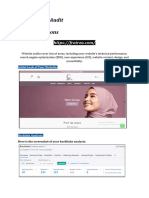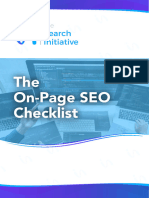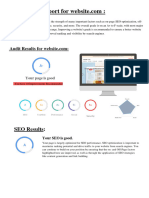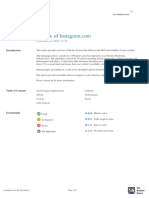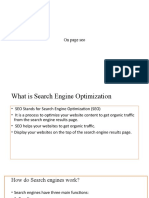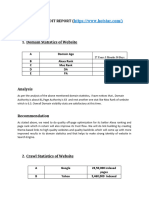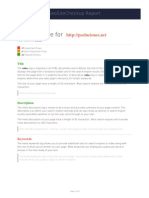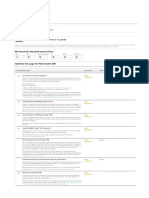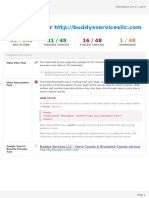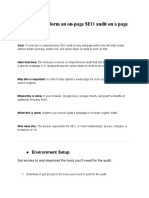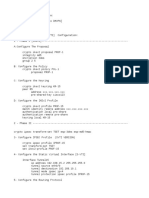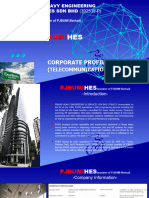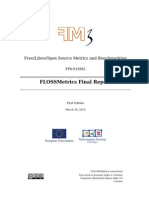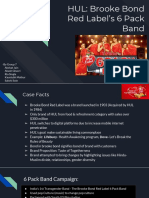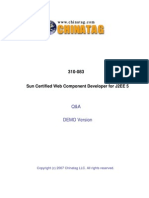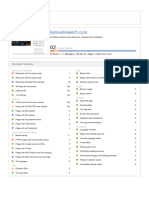On Page
Word Counts
This graph shows the amount of URLs with different word count ranges, so you can see if you have lots of URLs with only a small number of
words – which could be considered thin content.
10
Number of URLs
1
None 1-25 26-50 51-100 101-250 251-500 501-900 900+
Word Count Ranges
Words
Range URLs
No words found 0
1 to 25 Words 1
25 to 50 Words 3
50 to 100 Words 4
100 to 250 Words 4
250 to 500 Words 4
500 to 900 Words 0
900+ Words 0
Image Alt Text
The options below present three different ways to access image alt text data, either at an image level, or a page level (HTML URLs).
State URLs
Images (<img>) with Alt Text 0
Images (<img>) with Missing or empty Alt Text 0
HTML URLs with Images Missing Alt Text 0
1 of 5
�Title Length Title Identification
This chart shows the distribution of URLs based on the length of This chart shows the distribution of URLs based on the number of title
their title tag, in characters. tags present..
6.3% 0.0% 0.0% 0.0%
18.8%
75.0%
100.0%
Empty Too Short (< 40 ch)
Good (40-60 ch) Too Long (> 60 ch) Missing Only One More Than One
Meta Description Length Meta Description Identification
This chart shows the distribution of URLs based on the length of This chart shows the distribution of URLs based on the number of
their meta description, in characters. meta descriptions present.
0.0% 0.0%
0.0% 0.0%
100.0%
Empty Too Short (< 110 ch)
Good (110-230 ch) Too Long (> 230 ch) Missing Only One More Than One
Header 1 Length Header 1 Identification
This chart shows the distribution of URLs based on the length of This chart shows the distribution of URLs based on the number of h1
their header 1, in words. tags present.
0.0% 0.0% 0.0% 6.3%
13.3%
86.7%
93.8%
Empty Too Short (< 3 words)
Good (3-10 words) Too Long (> 10 words) Missing Only One More Than One
2 of 5
� On Page Score
Critical 0 High 0 Medium 1 Low 4 Insights 0 No Issue 16
95
All Hints 5 Issues 0 Potential Issues 1 Opportunities 4
Medium Opportunity <h1> tag is missing
URLs: 1 Percentage: 6.25% Indexable: 0 Not Indexable: 1
HTML URLs that do not contain a header 1. The header 1 (h1) tag is considered important to help both users and search engines to quickly
understand what content they can expect to find on the page. If the <h1> is not present, this represents a missed optimization opportunity.
Low Potential Issue Meta description is missing
URLs: 16 Percentage: 100% Indexable: 0 Not Indexable: 16
URLs that do not contain a meta description. The meta description is considered important to help users quickly understand what content they
can expect to find on the page, when clicking through from the search engine results page. Well written meta descriptions typically achieve a
better click-through-rate. If the meta description is missing, this represents a missed optimization opportunity.
Low Opportunity <h1> length too short
URLs: 13 Percentage: 81.25% Indexable: 0 Not Indexable: 13
URLs that contain a header 1 with too few words. If the <h1> does not use many words, in may not be well optimized to effectively
communicate the desired message. It is considered best practice to try and include the main target keywords for the page in the <h1>, whilst
also communicating 'what the page is about.'
Low Opportunity Title tag length too short
URLs: 12 Percentage: 75% Indexable: 0 Not Indexable: 12
URLs that contain a title tag with too few characters. If the title uses too few characters, it may not be sufficient to effectively communicate the
desired message.
Low Opportunity Title tag length too long
URLs: 1 Percentage: 6.25% Indexable: 0 Not Indexable: 1
URLs that contain a title tag with too many characters. If the title uses too many characters, it may not be well optimized to effectively
communicate the desired message. Depending on the query, search engines may truncate or rewrite titles that are too long.
No Issue HTML is missing or empty
URLs that do not contain any HTML. If there is no HTML content, then users and search engines alike will not be able to access any visible
content.
3 of 5
� No Issue Title tag is empty
HTML URLs that contain an empty <title> element. The title tag is considered one of the most important on-page SEO factors, so if it is not
present this represents an issue that may affect search engine rankings and click-through-rate from the search results.
No Issue Title tag is missing
HTML URLs that do not contain the <title> element. The title tag is considered one of the most important on-page SEO factors, so if it is
missing this represents an issue that may affect search engine rankings and click-through-rate from the search results.
No Issue Title tag outside of <head>
URLs that contain a title tag which has been placed outside the <head>. The title tag is considered one of the most important on-page SEO
factors, and if it is not located in the <head> it may be ignored by search engines, which will likely lead to lower engagement or CTR from
search results, and may also have an impact on search rankings.
No Issue Meta description outside of <head>
URLs that contain a meta description which has been placed outside the <head>. As a result, in most situations it will seem as though the page
does not have a meta description at all, which in itself is a missed optimization opportunity, and it may result in search engines re-writing the
meta description.
No Issue Multiple title tags
URLs that contain more than one <title> element. If there are multiple title tags on the page, it may lead to search engines displaying the
'wrong' one, which in turn may lead to lower engagement or CTR from search results, and may also have an SEO impact.
No Issue <h1> tag is empty
HTML URLs that have an empty header 1. The header 1 (h1) tag is considered important to help both users and search engines to quickly
understand what content they can expect to find on the page. If the <h1> is empty, this represents a missed optimization opportunity.
No Issue Contains Lorem Ipsum dummy text
URLs that contain 'Lorem Ipsum' dummy text in the body content. 'Lorem Ipsum' is nonsensical and improper Latin text that is used by website
designers as placeholder copy, and it is not uncommon for websites to get published with sections of 'Lorem Ipsum' copy still present. This
means that any pages which contain 'Lorem Ipsum' copy offer a poor user experience, and are under-optimized from an SEO standpoint.
No Issue Images with missing alt text
Images with no alt attribute or missing alt text. Alt text is important for accessibility, to communicate meaning and context about the image to
visually impaired users. Search engines also use alt text to understand the meaning and context, so images with no alt text represent poor
accessibility, and a missed SEO opportunity.
No Issue <h1> length too long
URLs that contain a header 1 with too many words. If the <h1> uses too many words, in may not be well optimized to effectively communicate
the desired message. It is considered best practice to try and include the main target keywords for the page in the <h1>, whilst also
communicating 'what the page is about.'
4 of 5
� No Issue Meta description is empty
URLs that have an empty meta description. The meta description is considered important to help users quickly understand what content they
can expect to find on the page, when clicking through from the search engine results page. Well written meta descriptions typically achieve a
better click-through-rate. If the meta description is empty, this represents a missed optimization opportunity.
No Issue Meta description length too long
URLs that contain a meta description with too many characters. If the meta description is very long, this may mean it has been automatically
generated or is not well optimized, and may achieve poor click-through-rate as a result. Depending on the query, search engines may truncate
or rewrite meta descriptions that are too long.
No Issue Meta description length too short
URLs that contain a meta description with too few characters. If the meta description is particularly short, this may mean it has been
automatically generated or is not well optimized, and may achieve poor click-through-rate as a result.
No Issue Multiple <h1> tags
URLs that contain multiple header 1s. Having more than one <h1> tag can be a sign of poor content structure, and could de-emphasize
keyword associations with the page.
No Issue Multiple meta descriptions
URLs that contain multiple meta descriptions. If there are multiple meta descriptions on the page, it may lead to search engines displaying the
'wrong' one, which in turn may lead to lower engagement or CTR from search results.
No Issue Title and meta description are the same
URLs that have identical text for the title and meta description. The title and meta description serve very different purposes, and if they are
identical then this is usually the result of a misconfigured plugin or script.
5 of 5










